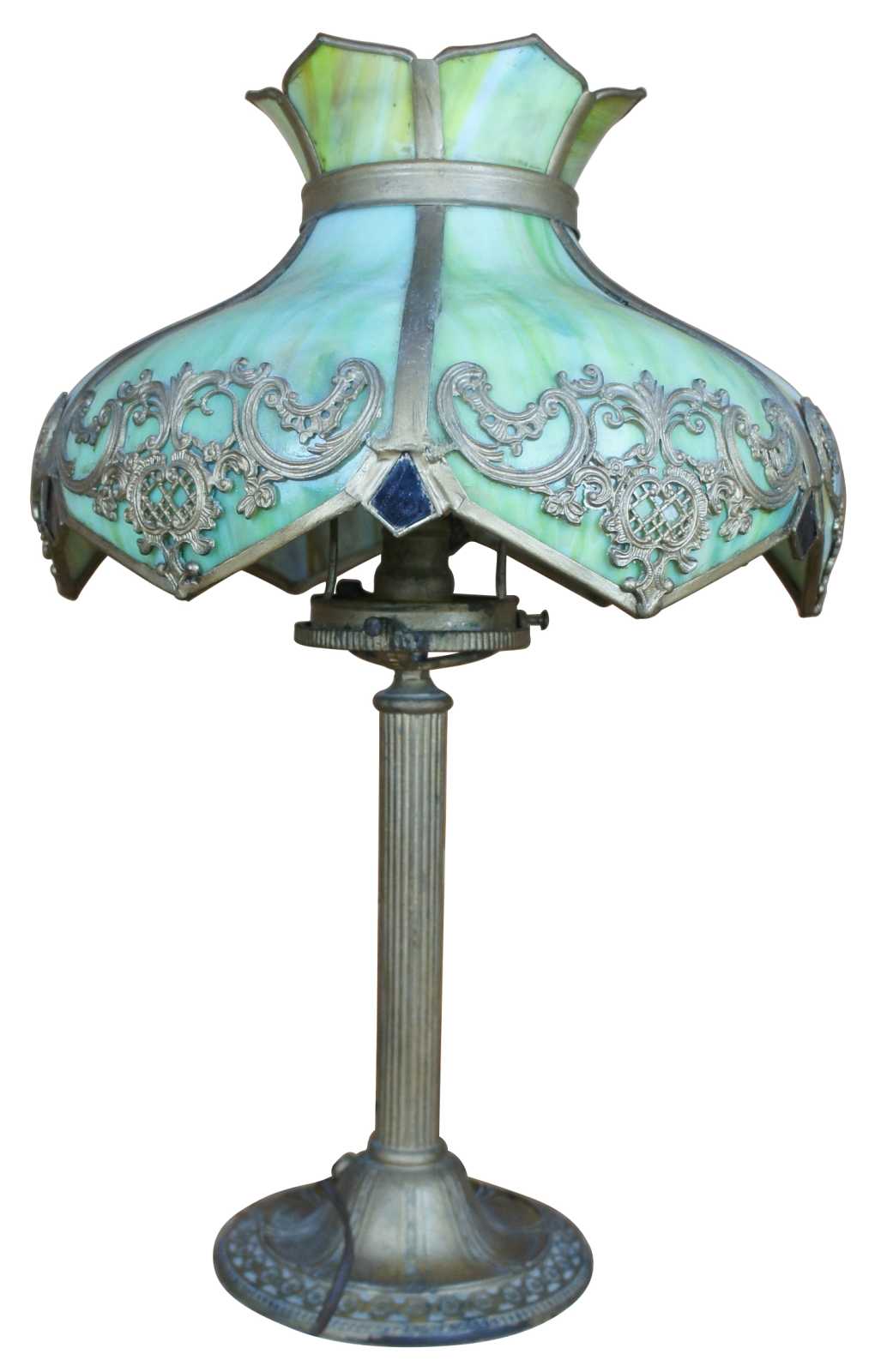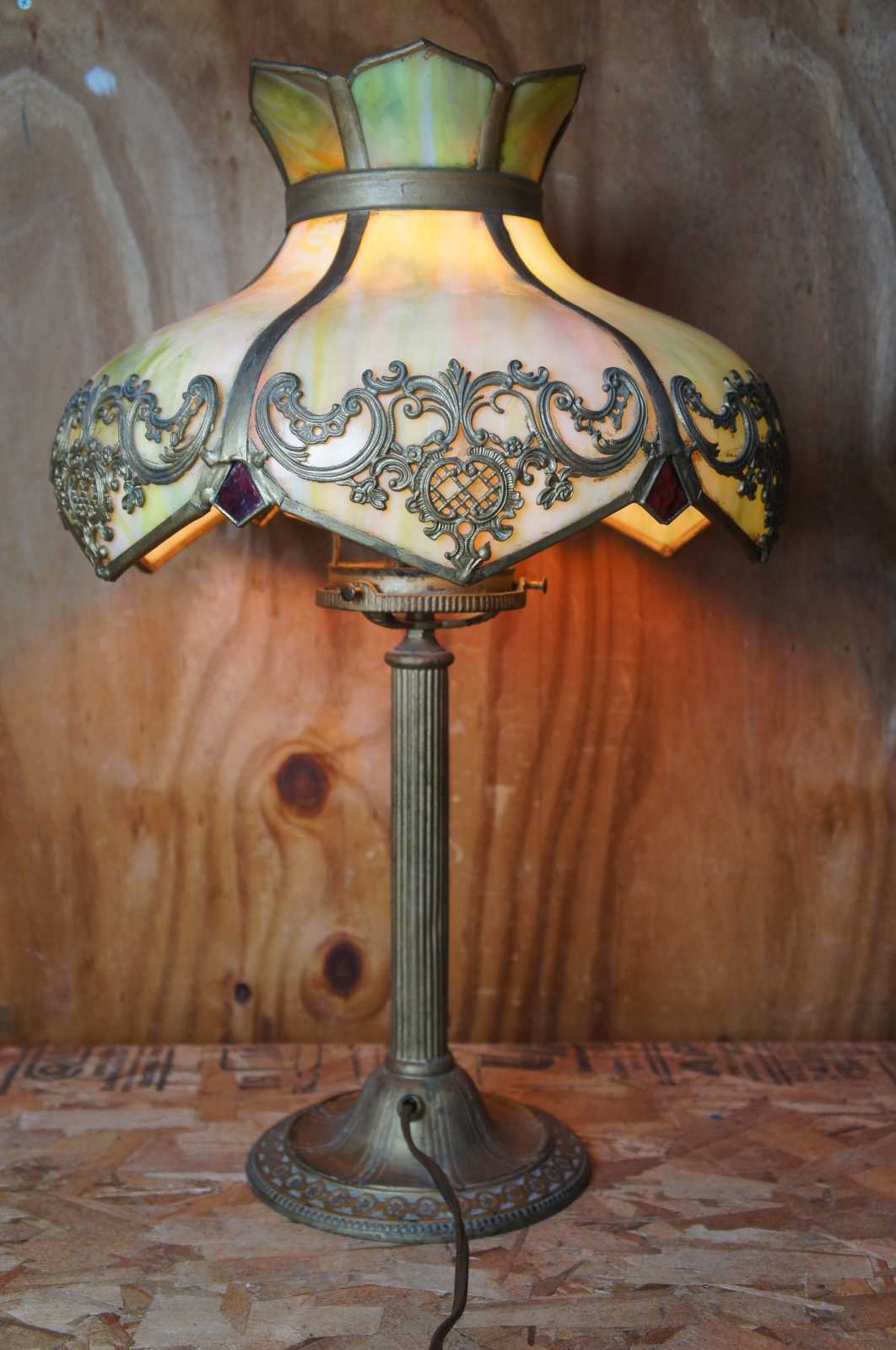
Antique Art Deco Miller Lamp Co. Arts & Crafts Stained Slag Glass ML 236 22"
Sold
Shipping:
Free Shipping Included
Delivery:
Estimated 2-15 Business Days
Payments:
Credit Card, Check, Cash, PayPal, Apple Pay, Venmo
Returns:
30 Days 100% Money Back Guarantee, Buyer Pays Return Shipping
Description
Antique Art Deco era slag glass lamp featuring arts and crafts styling with green slag glass shade and ornate brass work.
Edward Miller started his business in Meriden, Connecticut, in the 1840's making and selling camphene and burning fluid burners. By the 1860's, Edward Miller had become an aggressive competitior in the lamp business.
In 1844 when Horatio N. Howard opened a small shop in Meriden, Conn. that made screws, candle holders, candle stick springs, as well as lamps that burned whale oil and a variety of burning fluids.2 In 1845, Edward Miller took over Howard's business. He faced a number of initial obstacles: poor facilities, lack of raw materials and primitive manufacturing methods. Miller overcame these challenges and eventually moved into better quarters, introduced steam power into the plant, and increased production. Disaster struck in 1857 when fire destroyed the shop. It was quickly rebuilt, and business continued to expand and prosper.3
When Colonel Edwin L. Drake struck oil in Titusville in 1859, kerosene quickly became a safe and affordable lamp fuel. Miller envisioned an immediate need for burners for the new fuel and siezed the opportunity. In 1866, Miller formed a Joint Stock Company and reorganized under the name of Edward Miller & Co. The manufacturing capacity of the firm was immediately increased.4 In 1868, Miller constructed a brass rolling mill to keep up with his company's demand for brass, and to ensure a more consistent quility of product than he could count on from his suppliers. The Miller Rolling Mill would become a major division of the corporation.
A shrewd businessman, Miller never rested on his laurels. He strove for perfection and insisted upon the highest quality for all his products. As the times changed, so did types of illumination. As gas became a viable fuel source for cooking, heating and illumination, Miller entered into the manufacture of gas lighting fixtures and stoves. As the age of electricity beckoned, Miller followed the trend, or more appropriately, blazed new trails. He improved upon Thomas Edison's carbon filiment lamp by designing a tungsten filiment lamp. Miller pioneered mercury vapor and fluorescent lighting systems in the late 1930's as well.
Starting around 1884 through 1892, Edward Miller & Company manufactured the ""ROCHESTER"" line of lamps for The Rochester Lamp Company, located at 42 Park Place and 37 Barclay Street, New York City. They billed themselves as ""The largest wholesale and retail lamp store in the world,"" with branch stores in London, Paris and Chicago. Edward Miller produced, according to the catalog, 2000 designs and of variations of the Rochester, and in every manner of lamp - table, hanging store lamp, hanging library lamp, pull-down hall lamps, bracket lamps, night lamps, and more. After 1892, The Bridgeport Brass Company was awarded the contract to manufacture the lamps for The Rochester Lamp Company, which were then branded ""New Rochester"" to distinguish them from the former.
Edward Miller died in 1909 at the age of 82. The Miller Company continued to produce it's wares to his high standards and is still in existence today.
From December 4, 1860 to May 12, 1942, the company gained the rights to at least 139 lighting-related patents. See the patent table below for details. These include lamps, lanterns, burners, lampfillers, bicycle lamps, hanging lamp components of all descriptions, and metal spinning processes. Miller's most famous burner was named for it's inventor, John J. Marcy. Marcy assigned six patents to Miller, and may have been in Miller's employ during the 1860's. Marcy has at least eleven lighting patents to his credit. Other notable inventors include Frank Theodore Williams, assignor of twenty-three patents; Frank Rhind, assignor of twenty-seven patents, and William C. Homan, assignor of thirty-seven patents to Edward Miller & Co.
Condition
Good antique condition, wear and distressing commensurate with age and use, pitting / finish loss.
Dimensions
14.5" x 22.25"h










